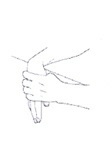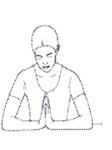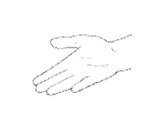When you first start to move your wrist and hand again you will normally feel pain and stiffness. The pain may increase to begin with.
Try to do the exercises little and often throughout the day - start slowly and gently increase gradually
It is normal for your wrist to take several months to recover and to get back normal movement and use after a fracture Contact your doctor or physiotherapist (if you have been referred) if the pain and swelling continue to get worse over time

Support your forearm on a table with your hand over the edge and palm facing down.
Let your hand drop down. Gently help the movement with your other hand.
Hold for 5-10 seconds.
Repeat 10 times.

Sit or stand. Forearms horizontally in front of you and palms together.
Push palms together for 5 seconds. Relax.
Repeat 10 times.

Forearm on a table, palm turned down.
Turn your palm up and then down keeping your elbow still.
Repeat 10 times.
Hold fingers and wrist straight.
Bend wrist first towards your little finger and then towards your thumb.
Repeat 10 times.







